The Labyrinth is a good metaphor for the human mind. The study of the physical structure of the brain has further strengthened the relationship between the two. Neurons are connected to each other to form neural networks which are so complex that each one is unique: every human being conceives ideas, thoughts and emotions inside his own personal labyrinth.
“Labirinti mentali” (Mental Mazes) is also the title of Antonio Argus’ show: the artist from Turis is a mentalist, and playing on mental paths is the very core of its activity as a magician. But given that playing a violin and writing a tweet are activities following different paths inside a brain, which are the peculiarities of the creative paths of a mentalist?
The career of a mentalist springs from a moment of frustration: the one in which she realizes that mind powers are different from what is expected. That moment is brilliantly portrayed in a scene from Wachowskis’ movie Matrix, when the main character meets a child endowed with psychokinetic powers.
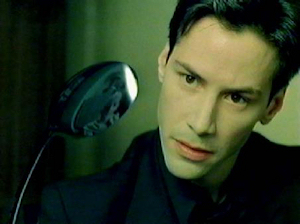
The kid has just bent a spoon with the power of his mind and Neo is staring at him with puzzlement: he would like to learn to do it, but every attempt seems vain.
Spoon boy: Do not try and bend the spoon. That’s impossible. Instead... only try to realize the truth.
Neo: What truth?
Spoon boy: There is no spoon.
Neo: There is no spoon?
Spoon boy: Then you’ll see, that it is not the spoon that bends, it is only yourself.
Discovering that Nature cannot be bent by using psychic rays is a shock one can cope with, just realizing that – also without “radiant energies” of any kind – a mind can influence another one, creating a perfect illusion of the fact that Nature has been bent. Mentalism is the art of reprogramming cerebral and emotional paths in a brain in order to surprise someone and leave her spechless. It may happen not necessarily in the shadow of a theater: following the evolution of Modern Art, mentalism offers today immersive performances in which times and spaces are far from the ones regulating the hypnotic shows in the 19th century.
On August 26th, 2015 I have visited with Francesco Busani and Miriam Iezzi the huge Franco Maria Ricci’s Labyrinth, covering over 8 hectares of land in the countryside near Parma and grown out with a variety of bamboo species. Looking at it with the “eye of the mentalist”, we clearly perceived Neo’s frustration, observing that we could not alter its structure made up of solid bamboo stems and cement. Then we shifted the focus to the map distributed at the entrance: without it, you get lost for sure. It was useful inasmuch “faihtful reproduction” of the place we were in: from the inside, it was impossible to know where we were, and looking at the map was like projecting our eyes in the heavens – the point of view from which a god would have seen us like Pac Man.
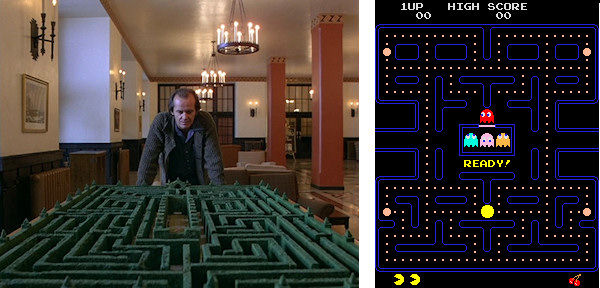
Left: Jack Torrance in Shining (1980) by Stanley Kubrick.
Right: Pac Man Maze (1980).
Being the only lifeline for not getting lost, the map was also our weakness – and therefore the perfect gateway to an action of hacking. We got the idea not to change the physical labyrinth but its plan. Back home we scanned it, designed a series of alterations and digitally changed its structure.
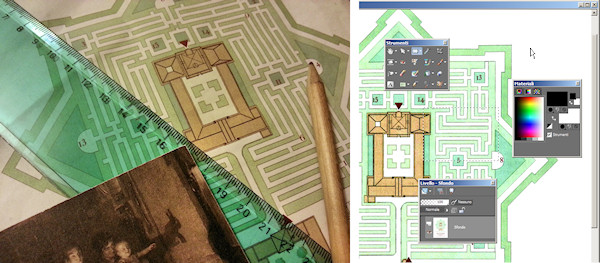
Then we printed one hundred modified maps totally similar to the original.
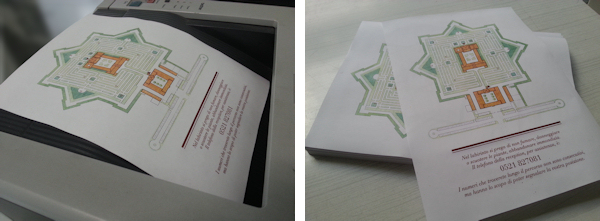
We returned to the maze and left the altered copies on a table, ready to be taken and used by a hundred unsuspecting visitors.
The study of alterations was meticulous: we left unchanged the initial part of the route to give a reassuring feeling of control. The first difficulty emerges to a quarter of the way, when the visitor reaches the pitch which has the number 4 (see map at left), marked with the number 8 on the altered map (see map to right):
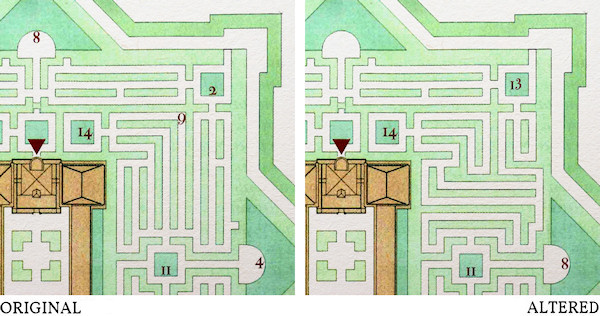
To regain the sense of direction one must return to the pitch 11 and move upward; from here on, however, the two maps differ completely, and it becomes impossible to understand where you are: map and territory are now at a huge distance.
Such an action is probably illegal. To overcome this problem, me and Francesco simply lied. We have never returned to the maze nor we distributed any altered copy: we just conceived the joke and documented it in detail in this post; again it is not the spoon actually bending but the mind of the observer perceiving it: our goal was not to “inject” a series of fake maps inside the maze of Franco Maria Ricci, but to convince you that we did it, accompany you to evaluate the consequences of the act and appreciate the tricky work behind the scenes. This post is not the description of a performance of mentalism: this post is the performance of mentalism itself.
But after we have revealed the trick, do you think you have more clear what happened? If you think so, you’re wrong. Indeed, there is another aspect: if we had really left a hundred fake maps in maze near Parma, we could have written this post to deny it – and thus relieve us of all responsibility. This leaves you in front of a forking path, unable to “solve” the mystery and find out what really happened. How many bluff are in this article? Where does the lie end and the truth begin?
Tzvetan Todorov uses the term “fantastic” to define literature offering readers the
hesitation experienced by a person who knows only the laws of nature, confronting an apparently supernatural event. (1)
The Bulgarian philosopher observes that the “fantastic” lasts only the time of such hesitation. Mentalism is an art placing the viewer (or in the case of this article, the reader) in the same unsettling state of insoluble hesitation.
1. Tzvetan Todorov, The Fantastic: A Structural Approach to a Literary Genre, 1975, p. 25.
BY-NC-SA 4.0 • Attribution-NonCommercial-ShareAlike 4.0 International